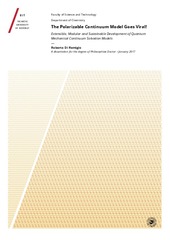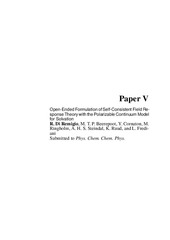| dc.contributor.advisor | Frediani, Luca | |
| dc.contributor.author | Di Remigio, Roberto | |
| dc.date.accessioned | 2017-03-20T13:46:18Z | |
| dc.date.available | 2017-03-20T13:46:18Z | |
| dc.date.issued | 2017-01-16 | |
| dc.description.abstract | Synergistic theoretical and experimental approaches to challenging chemical problems have become more and more widespread, due to the availability of efficient and accurate ab initio quantum chemical models. Limitations to such an approach do, however, still exist. The vast majority of chemical phenomena happens in complex environments, where the molecule of interest can interact with a large number of other moieties, solvent molecules or residues in a protein. These systems represent an ongoing challenge to our modelling capabilities, especially when high accuracy is required for the prediction of exotic and novel molecular properties. How to achieve the insight needed to understand and predict the physics and chemistry of such complex systems is still an open question. I will present our efforts in answering this question based on the development of the polarizable continuum model for solvation. While the solute is described by a quantum mechanical method, the surrounding environment is replaced by a structureless continuum dielectric. The mutual polarization of the solute-environment system is described by classical electrostatics. Despite its inherent simplifications, the model contains the basic mathematical features of more refined explicit quantum/classical polarizable models. Leveraging this fundamental similarity, we show how the inclusion of environment effects for relativistic and nonrelativistic quantum mechanical Hamiltonians, arbitrary order response properties and high-level electron correlation methods can be transparently derived and implemented. The computer implementation of the polarizable continuum model is central to the work presented in this dissertation. The quantum chemistry software ecosystem suffers from a growing complexity. Modular programming offers an extensible, flexible and sustainable paradigm to implement new features with reduced effort. PCMSolver, our open-source application programming interface, can provide continuum solvation functionality to any quantum chemistry software: continuum solvation goes viral. Our strategy affords simpler programming workflows, more thorough testing and lower overall code complexity. As examples of the flexibility of our implementation approach, we present results for the continuum modelling of non homogeneous environments and how wavelet-based numerical methods greatly outperform the accuracy of traditional methods usually employed in continuum solvation models. | en_US |
| dc.description.doctoraltype | ph.d. | en_US |
| dc.description.popularabstract | Beregningsbasert kjemi er blitt et viktig verktøy som komplementerer eksperimentel kjemi. Teoretiske modeller av molekylære systemer, basert på kvantemekaninkk, kan bidra til en bedre forståelse av molekylær egenskaper og til å forutsi nye kjemiske prosesser. Omgivelsene kan påvirke disse egenskapene og det er viktig å utivkle teoretiske modeller som kan beskrive det.
Systemene er vanligvis så store at også de største datamaskinene ikke har nok regnekraft for å bruke de mest nøyaktige metodene. Derfor bruker vi flerskalamodeller som kombinerer nøye kvantekjemiske metoder for molekylet med raskere klassiske metoder for omgivelsene. Vi har forsket på hvordan man kan gjennomføre slike beregninger og spesielt på hvordan man kan beskrive omgivelsene på en enkel måte.
Vi har funnet ut hvordan man kan beskrive omgivelsene på en måte som kan være både nøye og enkelt å bruke. Resultatene bidrar til kunnskap om hvordan vi kan beregne molekylære egenskap av molekyler nøye og raskt og viser hvor videre metodeutvikling er nødvendig. Dermed kan resultatene bidra til beregningsbasert kjemi innenfor for eksempel kjemisk katalyse eller medisinutvikling. | en_US |
| dc.identifier.isbn | 978-82-8236-234-4 (trykket) og 978-82-8236-235-1 (pdf) | |
| dc.identifier.uri | https://hdl.handle.net/10037/10786 | |
| dc.language.iso | eng | en_US |
| dc.publisher | UiT Norges arktiske universitet | en_US |
| dc.publisher | UiT The Arctic University of Norway | en_US |
| dc.rights.accessRights | openAccess | en_US |
| dc.rights.holder | Copyright 2017 The Author(s) | |
| dc.rights.uri | https://creativecommons.org/licenses/by-nc-sa/3.0 | en_US |
| dc.rights | Attribution-NonCommercial-ShareAlike 3.0 Unported (CC BY-NC-SA 3.0) | en_US |
| dc.subject | VDP::Mathematics and natural science: 400::Chemistry: 440::Theoretical chemistry, quantum chemistry: 444 | en_US |
| dc.subject | VDP::Matematikk og Naturvitenskap: 400::Kjemi: 440::Teoretisk kjemi, kvantekjemi: 444 | en_US |
| dc.title | The Polarizable Continuum Model Goes Viral!
Extensible, Modular and Sustainable Development of Quantum Mechanical Continuum Solvation Models | en_US |
| dc.type | Doctoral thesis | en_US |
| dc.type | Doktorgradsavhandling | en_US |


 English
English norsk
norsk





